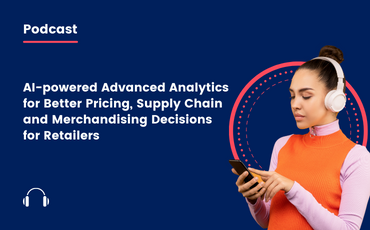
Retail Demand Forecasting: What, How, and Why?
“The only thing that is constant is change.”
-Heraclitus
Heraclitus couldn't have been more right, especially when it comes to demand forecasting in retail. Today’s customer preferences and expectations are more complex than ever. Purchasing channels and methods, fulfillment preferences, and customer segments are more dimensional and very different from classical models. That makes it increasingly harder for retailers to make better and more reliable forecasts to get the right inventory to the right location.
Now for many retailers, whether they are omni-channel champions or small brick-and-mortar stores, forecasting is king. Because it leads the way to better decision-making and execution. But it is important to remember that forecasting will always be inaccurate to some degree, without a crystal ball to predict the future. Still, it is a critical enabler for better inventory planning, and it is what holds the key to successful allocation and replenishment decisions.
So, what is demand forecasting in retail really? How is it done? What do retailers need to create better forecasts? Let’s find out.
1. What is Demand Forecasting?
Demand forecasting in retail is fundamentally the process of developing an estimate of the future customer demand. It includes the analyses of numerous internal and external variables that impact demand -from seasonality to promotions, inventory levels to market trends.
The goal is to utilize a variety of data inputs to drive better forecast accuracy and satisfy customers with less inventory.
2. Why Is Forecast Accuracy Important?
In today’s retail climate, retailers need richer and more accurate forecasts
-To be able to position the right amount of inventory at each location in their network to meet the demand,
-Optimize inventory and pricing decisions,
-And maximize profit.
We know that demand forecasting will never be perfectly accurate, despite the increasing availability of data. However, it is always better to be more accurate as inventory success is contingent on knowing how inaccurate your forecasts are.
By leveraging machine learning algorithms and using a robust forecasting system that monitors the change in the demand side and aligns the supply side to make up for the inaccuracy of the forecasts and randomness in demand, retailers can increase their inventory and planning efficiency. And this requires:
- Near zero bias at various levels of aggregation (e.g. at product-chain level)
- Correct directional response to external variables (promos, seasonality, weather, local events)
- Error (inaccuracy) measurement and the right amount of inventory positioning.
3. Why Do Retailers Need Granular-Level Demand Forecasting?
Forecasting demand successfully is essential in retail, where customers are demanding, competitors are fierce, and supply chains are complex. To make better buying decisions and accelerate production, allocation, and replenishment capabilities, retailers need to forecast demand in different levels of granularity that look at different time frames.
And forecasts at all levels of granularity - hourly, daily, weekly, or monthly – can be extremely valuable for businesses that aim to meet customer demand, gain competitive advantage, and increase profits.
It enables demand planners and supply chain professionals to improve inventory decision-making and better understand, predict, and plan their products. Generating granular level forecasts also helps retailers reduce lost sales and customer returns while lowering safety stocks and preventing spoilage.
4. How Can Retailers Forecast Demand Better?
From grocery to apparel, all retailers rely on forecasts in their demand planning to order products based on the best sales estimations and position inventory at the right amount at each location. And it’s not an easy task for retailers to forecast demand accurately when they are responding to a market that is so dynamic.
Retailers can choose many ways and methods to predict future demand today. But relying on spreadsheets, assumptions, and manual processes to create accurate forecasts is not a good option anymore.
The best retailers no longer guess what customers want, instead, they use future-ready demand forecasting tools and leverage machine learning algorithms and to predict customer behavior with higher accuracy. AI-based demand forecasting solutions they use such as Invent Analytics’ Demand Forecasting, take into account many variables to predict the sales probability and demand variation.
These include:
- Seasonality and special days,
- Promotion and markdown uplifts,
- Cannibalization effect,
- Inventory levels,
- Product substitutions,
- Competitors’ prices and activities,
- Market trends,
- Local events, weather,
- And characteristics of store locations.
AI-based demand forecasting solutions process enormous data sets to address a wide range of planning needs. They take into account hundreds of demand-influencers to generate better forecasts. This helps retailers automate decisions, optimize inventory, and create a smart planning process.
5. Why Is Demand Forecasting Important for Retailers?
Retailers are often faced with the dilemma of either overstocking or understocking. And finding a happy medium is not always easy. Holding too much inventory can be a costly mistake as it may result in clearance sales and a loss of revenue.
On the other hand, understocking can lead to lost sales and unfulfilled demand which can potentially drive customers away for good. Not finding the right balance can also have a far-reaching impact on supply chain planning, inventory holding cost, and ultimately profitability.
Efficient inventory planning is the backbone of retailers’ success’ and it all starts with demand forecasting. The more accurately retailers forecast demand and plan accordingly, the chances are higher for enhanced customer satisfaction, increased inventory availability, and top-line growth.
6. What Are the Benefits of Highly Accurate Demand Forecasting in Retail?
Better planning in retail supply chains and smarter business decisions require highly accurate demand forecasting. When achieved that, retailers enjoy great benefits that come with it, such as:
- Making more informed inventory decisions,
- Increasing inventory turns by reducing out-of-stocks and excess inventory,
- Reducing costs by eliminating risk and unnecessary markdowns,
- Improving customer experience,
- Fine-tuning logistics and transportation planning,
- Enhancing productivity by planning ahead,
- Reducing waste,
- And improving inventory management.
How Invent Analytics Empowers Retailers with Demand Forecasting
Invent Analytics offers a future-ready, AI-powered demand forecasting solution that helps retailers generate highly accurate forecasts in the omni-channel world. Engineered specifically to help retailers meet the ever-evolving customer demand, Invent Analytics enables positioning inventory smartly at the right amount at each location.
With Invent Analytics’ Demand Forecasting Solution, retailers achieve remarkable results. (Take a look at our customer success stories here for more.)
They can also
- Create more accurate short-term baseline forecasts at the SKU/zipcode/day/fulfillment preference level for long-life products as well as for short-life or highly seasonal products,
- Make more accurate long-term and promotional forecasts by using our AI-Powered probabilistic demand forecasting system,
- Leverage explainable AI and fast learning algorithms to predict how, when, and where their omni-channel customers want their orders to be fulfilled,
- Determine the right amount of inventory required in your stores and distribution centers,
- Detect demand shifts quickly and adapt to changing demand,
- Handle high volatility environments effectively,
- And achieve greater visibility into the future for better planning.

Looking to the Future
Executing a successful demand forecasting strategy is critical for better planning, but it is also highly challenging. And the fact is that retailers can no longer afford to manage their inventory planning operations in silos with traditional planning systems.
To succeed, retailers need to leverage modern inventory planning systems. And every successful inventory planning must start with AI-powered demand forecasting. After all, mastering forecasting can become a source of competitive advantage and help retailers meet the customer expectations of tomorrow, not today.
So, if you’re interested in putting demand forecasting at the heart of strategic decision-making in your planning and staying ahead of the curve, get in touch with our retail experts today. Schedule a free demo and see Invent Analytics’ Demand Forecasting in action.



